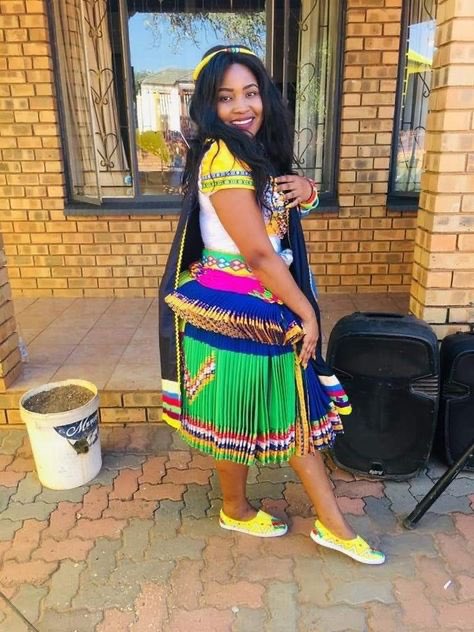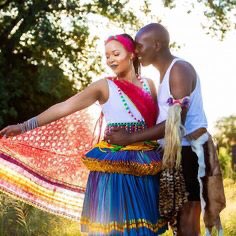Vatsonga
Vatsonga are a Bantu ethnic group native mainly to Southern Mozambique and South Africa (Limpopo and Mpumalanga). They speak Xitsonga, a Southern Bantu language. A very small number of Tsonga people are also found in Zimbabwe and Northern Swaziland.
Vatsonga are a Bantu ethnic group native mainly to Southern Mozambique and South Africa (Limpopo and Mpumalanga). They speak Xitsonga, a Southern Bantu language. A very small number of Tsonga people are also found in Zimbabwe and Northern Swaziland.
The Tsonga people of South Africa share some history with the Tsonga people of Southern Mozambique; however they differ culturally and linguistically from the Tonga people of Zambia and Zimbabwe.
Below is the traditional location of Tsonga people with dialectical differences and before the borders between Zimbabwe, Mozambique and Swaziland were imposed and the indigenous peoples were forcibly relocated by colonizers.
There are approximately 7,5 Million VaTsonga in the world:
 https://abs.twimg.com/emoji/v2/... draggable="false" alt="🇲🇿" title="Flagge von Mosambik" aria-label="Emoji: Flagge von Mosambik"> 4,1 Million being in Mozambique
https://abs.twimg.com/emoji/v2/... draggable="false" alt="🇲🇿" title="Flagge von Mosambik" aria-label="Emoji: Flagge von Mosambik"> 4,1 Million being in Mozambique
 https://abs.twimg.com/emoji/v2/... draggable="false" alt="🇿🇦" title="Flagge von Südafrika" aria-label="Emoji: Flagge von Südafrika"> 3.3 Million being in South Africa
https://abs.twimg.com/emoji/v2/... draggable="false" alt="🇿🇦" title="Flagge von Südafrika" aria-label="Emoji: Flagge von Südafrika"> 3.3 Million being in South Africa
 https://abs.twimg.com/emoji/v2/... draggable="false" alt="🇸🇿" title="Flagge von Swasiland" aria-label="Emoji: Flagge von Swasiland"> 2.7 Million being in Swaziland
https://abs.twimg.com/emoji/v2/... draggable="false" alt="🇸🇿" title="Flagge von Swasiland" aria-label="Emoji: Flagge von Swasiland"> 2.7 Million being in Swaziland
 https://abs.twimg.com/emoji/v2/... draggable="false" alt="🇿🇼" title="Flagge von Simbabwe" aria-label="Emoji: Flagge von Simbabwe"> 5000 being in Zimbabwe
https://abs.twimg.com/emoji/v2/... draggable="false" alt="🇿🇼" title="Flagge von Simbabwe" aria-label="Emoji: Flagge von Simbabwe"> 5000 being in Zimbabwe
History:
Vatsonga originated from Central and East Africa somewhere between AD 200 and 500, and have been migrating in-and-out of South Africa for over a thousand (1,000) years. Initially, the Tsonga people settled on the coastal plains of Northern Mozambique but finally...
Vatsonga originated from Central and East Africa somewhere between AD 200 and 500, and have been migrating in-and-out of South Africa for over a thousand (1,000) years. Initially, the Tsonga people settled on the coastal plains of Northern Mozambique but finally...
settled in the Transvaal Province and around parts of St Lucia Bay in South Africa from as early as the 1300s.
One of the earliest reputable written accounts of the Tsonga people is by Henri Philipe (HP) Junod titled "Matimu ya Vatsonga 1498-1650" which was formally published...
One of the earliest reputable written accounts of the Tsonga people is by Henri Philipe (HP) Junod titled "Matimu ya Vatsonga 1498-1650" which was formally published...
in 1977, and it speaks of the earliest Tsonga kingdoms. Before this, the older Henri Alexandri (HA) Junod released his work titled "The life of a South African Tribe" which was first published under two volumes in 1912-1913 and re-published in 1927.
The historical movements of the Tsonga people is dominated by separate migrations, with the Tembe people settling at the Southern parts of Swaziland around the 1350s and the Van& #39;wanati and Vanyayi settling in the eastern Limpopo region between the late 1400s and 1650s.
Separate migrations from parts of Mozambique occurred shortly thereafter and particularly during the 1800s. According to historical records acquired from the Portuguese (who are perhaps the first Europeans to ship to African soil in the 1400s) and Swiss Missionaries who arrived..
to Mozambique and South Africa in the 1800s, Portuguese sailors encountered Tsonga tribes near the coast of Mozambique. Early tribes identified are names such as the Mpfumo who belong to the Rhonga clan within the wider Tsonga (Thonga) ethnicity, and further identified during the
1500-1650 are the Valenga, Vacopi, Vatonga (Nyembana), Vatshwa, and Vandzawu. The Vatsonga people from very early on were much like a confederacy where different groups settled and assimilated within a particular area and adopted a similar language that differed on the basis of..
geographic location (dialect). Various dialects of the Thonga/Tsonga language emerged from around the 1200s or earlier, such as Xirhonga, Xin& #39;walungu, Xihlanganu, Xibila, Xihlengwe, and Xidjonga. They held large territorial areas in southern Mozambique and parts of South Africa
and extracted tribute for those who passed through (paying tribute was to secure passage or to be spared from attack). The Tsonga tribes also operated like a confederacy in supplying regiments to different groups in the northern Transvaal region during times of...
Great Zimbabwe establishment and engaged in trade. The Nkuna and Valoyi tribes which supplied soldiers to help the Modjadji kingdom; and the Nkomati and Mabunda tribes for supplying regiments to the army of Joao Albasini (Xipolongo empire). The Tsonga people have an age-old...
custom of leading their own tribes, with a senior traditional leader at the forefront of their own tribal establishment and is seen with a status equal to that of a king.
The Tsonga people have lived according to these customs for ages and they hold the belief that "vukosi a byi peli nambu" which is a metaphor meaning "kingship does not cross territorial or family borders".
Within apartheid South Africa, a Tsonga "homeland", Gazankulu Bantustan, was created out of part of northern Transvaal Province (Now Limpopo Province and Mpumalanga) during the 1960s and was granted self-governing status in 1973.
This bantustan& #39;s economy depended largely on gold and on a small manufacturing sector. However, only an estimated 500,000 people—less than half the Tsonga population of South Africa—ever lived there. Many others joined township residents from other parts of South Africa around
urban centres, especially Johannesburg and Pretoria.
The various groups who speak the Xitsonga language or one of its dialects are therefore also united by the language and take its name from it, hence Constitutionally they are the Tsonga people (Vatsonga). There are also other Tsonga groups in parts of Mozambique, Zimbabwe, and..
Swaziland. Other related groups outside of South Africa who are ancestral or related to the South African Tsonga people go by various tribal names (Tonga, Rhonga, Chopi, Tswa) but they are sometimes classified within the heritage and history of the Tsonga people of South Africa.
VaTsonga people speak the Xitsonga language, which is one of the official languages of the Republic of South Africa. According to historians, the Xitsonga language had already developed during the 1500s with its predecessor the "Thonga language" identified as the main origin.
It was mostly through the missionary work of the late 1800s to mid-1900s that led to a cohesive study of the Tsonga people& #39;s dialects and language features. The work carried out by Henri Junod and his father left a lasting legacy for the Tsonga people to rediscover their past..
history. It was however Paul Berthoud and his companion Ernest Creux who actively engaged with the Tsonga people of the Spelonken region to eventually produce the first hymn books written in the Xitsonga language at around 1878.
These Swiss Missionaries, however, did not understand the Xitsonga language at all and had to depend on the guidance of native speakers for the translations. The first book written in the Xitsonga language was published in 1883 by Paul Berthoud after dedicating enough time to...
learning the language. The Tsonga people themselves had then begun to learn to read and write in Xitsonga, however that the Tsonga people had already been well affluent in the Xitsonga language or one of its dialects long before the arrival of the Swiss Missionaries.
There is evidence to indicate that the "language was already-spoken by the occupants of the country more than 500 years" before the arrival of Swiss Missionaries.(Junod 1912, p. 32)

 Read on Twitter
Read on Twitter




